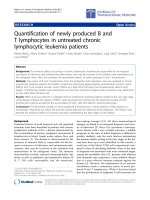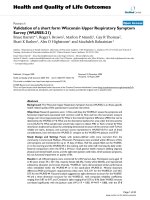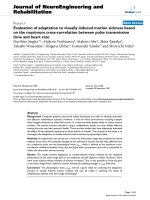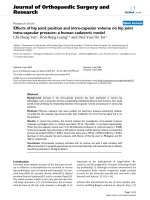Báo cáo hóa học: "OSCILLATION OF SECOND-ORDER NEUTRAL DELAY AND MIXED-TYPE DYNAMIC EQUATIONS ON TIME SCALES" pdf
Bạn đang xem bản rút gọn của tài liệu. Xem và tải ngay bản đầy đủ của tài liệu tại đây (510.05 KB, 9 trang )
OSCILLATION OF SECOND-ORDER NEUTRAL DELAY AND
MIXED-TYPE DYNAMIC EQUATIONS ON TIME SCALES
Y. S¸AH
˙
INER
Received 31 January 2006; Revised 11 May 2006; Accepted 15 May 2006
We consider the equation (r(t)(y
Δ
(t))
γ
)
Δ
+ f (t,x(δ(t))) = 0, t ∈ T,wherey(t) = x(t)+
p(t)x(τ(t)) and γ is a quotient of positive odd integers. We present some sufficient con-
ditions for neutral delay and mixed-type dynamic equations to be oscillatory, depending
on deviating arguments τ(t)andδ(t), t
∈ T.
Copyright © 2006 Y. S¸ahiner. This is an open access article distributed under the Creative
Commons Attribution License, which permits unrestricted use, distribution, and repro-
duction in any medium, provided the orig inal work is properly cited.
1. Some preliminaries on time scales
Atimescale
T is an arbitrary nonempty closed subset of the real numbers. The theory
of time scales was introduced by Hilger [6] in his Ph.D. thesis in 1988 in order to unify
continuous and discrete analysis. Several authors have expounded on various aspects of
this new theory, see [7] and the monographs by Bohner and Peterson [3, 4], and the
references cited therein.
First, we give a short review of the time scales calculus extracted from [3]. For any
t
∈ T, we define the forward and backward jump operators by
σ(t):
= inf{s ∈T : s>t}, ρ(t):= sup{s ∈T : s<t}, (1.1)
respectively. The graininess function μ :
T →[0, ∞)isdefinedbyμ(t):= σ(t) −t.
Apointt
∈ T is said to be right dense if t<supT and σ(t) =t, left dense if t>inf T and
ρ(t)
= t.Also,t is said to be right scattered if σ(t) >t,leftscatteredift>ρ(t). A function
f :
T → R is called rd-continuous if it is continuous at right dense points in T and its
left-sided limit exists (finite) at left dense points in
T.
For a function f :
T → R, if there exists a number α ∈ R such that for all ε>0
there exists a neighborhood U of t with
|f (σ(t)) − f (s) −α(σ(t) −s)|≤ε|σ(t) −s|,for
all s
∈ U,then f is Δ-differentiable at t,andwecallα the derivative of f at t and denote
Hindawi Publishing Corporation
Advances in Difference Equations
Volume 2006, Article ID 65626, Pages 1–9
DOI 10.1155/ADE/2006/65626
2 Oscillation of neutral dynamic equations
it by f
Δ
(t),
f
Δ
(t) =
f
σ(t)
−
f (t)
σ(t) −t
(1.2)
if t is right scattered. When t is a right dense point, then the derivative is defined by
f
Δ
(t) =lim
s→t
f (t) − f (s)
t −s
, (1.3)
prov ided this limit exists.
If f :
T → R is Δ-differentiable at t ∈ T,then f is continuous at t.Furthermore,we
assume that g :
T →R is Δ-differentiable. The following formulas are useful:
f
σ(t)
=
f (t)+μ(t) f
Δ
(t), ( fg)
Δ
(t) = f
Δ
(t)g(t)+ f
σ(t)
g
Δ
(t). (1.4)
A function F with F
Δ
= f is called an antiderivative of f , and then we define
b
a
f (t)Δt =F(b) −F(a), (1.5)
where a,b
∈ T. It is well known that rd-continuous functions possess antiderivatives.
Note that if
T
=
R,wehaveσ(t) =t, μ(t) =0, f
Δ
(t) = f
(t), and
b
a
f (t)Δt =
b
a
f (t)dt, (1.6)
and if
T
=
Z,wehaveσ(t) =t +1,μ(t) =1, f
Δ
= Δ f ,and
b
a
f (t)Δt =
b−1
t=a
f (t). (1.7)
If f is rd-continuous, then
σ(t)
t
f (s)Δs = μ(t) f (t). (1.8)
2. Introduction
In this paper, we are concerned with the oscillatory behavior of the second-order neutral
dynamic equation with deviating arguments
r(t)
y
Δ
(t)
γ
Δ
+ f
t,x
δ(t)
=
0, t ∈ T, (NE)
where y(t)
= x(t)+p(t)x(τ(t)), γ is a quotient of positive odd integers, r, p ∈ C
rd
(T,R)
are positive functions, τ,δ
∈ C
rd
(T,T), τ(t) ≤ t,lim
t→∞
τ(t) =∞,lim
t→∞
δ(t) =∞,and
f :
T ×R → R is continuous function such that uf(t,u) > 0forallu = 0.
Y. S¸ahiner 3
Unless otherwise is stated, throughout the paper, we assume the following conditions:
(H1) 0
≤ p(t) < 1,
(H2)
∞
(1/r(t))
1/γ
Δt =∞,
(H3) there exists a nonnegative function q defined on
T such that |f (t,u)|≥q(t)|u|
γ
.
By a solution of (NE), we mean a nontrivial real-valued function x such that x(t)+
p(t)x(τ(t)) and r(t)[(x(t)+p(t)x(τ(t)))
Δ
]
γ
are defined and Δ-differentiable for t ∈ T,
and satisfy (NE)fort
≥ t
0
∈ T.Asolutionx has a generalized zero at t in case x(t) = 0.
We say x has a generalized zero on [a,b]incasex(t)x(σ(t)) < 0orx(t)
= 0forsome
t
∈ [a,b), where a,b ∈ T and a ≤ b (x has a generalized zero at b,incasex(ρ(b))x(b) < 0
or x(b)
= 0). A nontrivial solution of (NE)issaidtobeoscillatoryon[t
x
,∞)ifithas
infinitely many generalized zeros when t
≥ t
x
; otherwise it is called nonoscillatory. Finally,
(NE) is called oscillatory if all its solutions are oscillatory.
In recent years, there has been a great deal of work on the oscillatory behavior of so-
lutions of some second-order dynamic equations. To the best of our knowledge, there
is very little known about the oscillatory behavior of (NE). Indeed, there are not many
results about nonneutral second-order equation in the form of (NE)whenp(t)
≡ 0. For
some oscillation criteria, we refer the reader to the papers [1, 2, 9, 12] and references cited
therein.
Subjecttoourcorrespondingconditions,Agarwaletal.[2] considered the second-
order neutral delay dynamic equation
r(t)
x(t)+p(t)x(t −τ)
Δ
γ
Δ
+ f
t,x(t −δ)
=
0, (2.1)
where τ and δ are positive constants. A part of this study contains two main theorems
proven by the technique of reduction of order. Previously obtained result about oscilla-
tion of first-order delay dynamic equation
z
Δ
(t)+Q(t)z
h(t)
=
0 (2.2)
is used to be compared with (2.1). One of them is the following which is auxiliary for the
proofofthefirsttheoremin[2].
Lemma 2.1 [11,Corollary2]. Assume h(t) <t.Define
α :
= limsup
t→∞
sup
λ∈E
Q
λe
−λQ
h(t),t
, (2.3)
where E
Q
={λ |λ>0, 1−λQ(t)μ(t) > 0, t ∈T},and
e
−λQ
h(t),t
=
exp
t
h(t)
ξ
μ(s)
−
λQ(s)
Δs,
ξ
l
(z) =
⎧
⎪
⎨
⎪
⎩
log(1 + lz)
l
if l
= 0,
z if l
= 0.
(2.4)
If α<1,theneverysolutionof(2.2)isoscillatory.
4 Oscillation of neutral dynamic equations
Theorem 2.2 [2, Theorem 3.2]. Assume that r
Δ
(t) ≥0.Theneverysolutionof(2.1)oscil-
lates if
limsup
t→∞
sup
λ∈E
A
λe
−λA
(t −δ,t)
< 1, (2.5)
where
A(t)
=
q(t)
1 − p(t −δ)
γ
r(t −δ)
t −δ
2
γ
. (2.6)
Theorem 2.3 [2, Theorem 3.3]. Assume that r
Δ
(t) ≥0.Theneverysolutionof(2.1)oscil-
lates if
limsup
t→∞
t
t
−δ
A(s)Δs>1. (2.7)
Note that the monotonicity condition imposed on r is quite restrictive and there-
fore Theorem 2.3 applies only to a special class of neutral-type dynamic equations. Also,
τ(t)
= t −τ and δ(t) =t −δ being just linear functions cause further restrictions.
The above results are of special importance for us and in fact they motivate our study
in this paper. Our purpose here, first of all, is to show that the conclusions of Theorems
2.2 and 2.3 are v alid without the monotonicity condition on r and requirements τ(t)
=
t −τ and δ(t) = t −δ. In the next section, we present some new oscillation criteria under
very mild conditions and more general assumptions to extend the above results for the
neutral delay and mixed dynamic equations.
3. Main results
Since we deal with the oscillatory behavior of (NE) on time scales, throughout the paper,
we assume that the time scale
T under consideration satisfies supT
=∞
.Welabel(NE)
as (NE)
d
or (NE)
m
that refers to neutral delay or mixed dynamic equation if δ(t) <tor
δ(t) >t, respectively.
Theorem 3.1. Let E
={λ |λ>0, 1−λg(t)μ(t) > 0}. Assume that δ(t) <t.If
limsup
t→∞
sup
λ∈E
λe
−λg
δ(t),t
< 1, (3.1)
where g(t)
= [1 − p(δ(t))]
γ
q(t),then(NE)
d
is oscillatory.
Proof. Assume, for the sake of contradiction, that (NE)
d
has a nonoscillatory solution
x(t). We may assume that x(t) is eventually positive, since the proof when x(t)iseven-
tually negative is similar. Because δ(t), τ(t)
→∞as t →∞, there exists a positive num-
ber t
1
≥ t
0
,suchthatx(δ(t)) > 0andx(τ(t)) > 0fort ≥ t
1
.Wealsoseethaty(t) > 0for
t
≥ t
1
.Wemayclaimthaty
Δ
(t) has eventually a fixed sign. If y
Δ
has a generalized zero on
I
= [t
2
,σ(t
2
)) for some t
2
>t
1
,then
r(t)
y
Δ
(t)
γ
Δ
I
=−f
t,x
δ(t)
< 0, (3.2)
Y. S¸ahiner 5
which implies that y
Δ
(t) cannot have another generalized zero after it vanishes or changes
sign once on the interval I. Suppose that y
Δ
(t) < 0fort ≥ t
3
≥ σ(t
2
). It is easy to see from
(NE)
d
that r(t)(y
Δ
(t))
γ
is nonincreasing. So we have
r(t)
y
Δ
(t)
γ
≤ r
t
3
y
Δ
t
3
γ
= d<0, t ≥ t
3
. (3.3)
Integration from t
3
to t yields
y(t)
≤ y
t
3
+ d
1/γ
t
t
3
1
r(s)
1/γ
Δs. (3.4)
In view of (H2), it follows from (3.4) that the function y(t) takes on negative values for
sufficiently large values of t. This contradicts the fact that y(t) is eventually positive, we
must have y
Δ
(t) > 0fort ≥ t
3
. Using this fact together with τ(t) ≤ t and x(t) <y(t), we
see that
y(t)
= x(t)+p(t)x
τ(t)
≤
x(t)+p(t)y
τ(t)
≤
x(t)+p(t)y(t) (3.5)
or
x(t)
≥
1 − p(t)
y(t), t ≥t
3
. (3.6)
Because of (H2), we have for sufficiently large t
≥ t
3
,
t
t
3
1
r
1/γ
(s)
Δs>1. (3.7)
By the nonincreasing property of r
1/γ
y
Δ
,
y(t)
= y
t
3
+
t
t
3
y
Δ
(s)Δs
≥
t
t
3
1
r
1/γ
(s)
r
1/γ
(s)y
Δ
(s)
Δs ≥r
1/γ
(t)y
Δ
(t)
t
t
3
1
r
1/γ
(s)
(3.8)
and using (3.7 ), we get
y(t)
≥ r
1/γ
(t)y
Δ
(t), t ≥ t
3
. (3.9)
There exists a number t
∗
= δ(t
3
) <t
3
≤ t such that the following holds from inequalities
(3.6)and(3.9):
x
δ(t)
≥
1 − p
δ(t)
r
1/γ
δ(t)
y
Δ
δ(t)
, t ≥ t
∗
. (3.10)
In view of (NE)
d
and (H3), we have
r(t)
y
Δ
(t)
γ
Δ
+ q(t)x
γ
δ(t)
≤
0. (3.11)
6 Oscillation of neutral dynamic equations
Substituting (3.10) into the last inequality, we obtain for t
≥ t
∗
,
z
Δ
(t)+
1 − p
δ(t)
γ
q(t)z
δ(t)
≤
0, (3.12)
where z(t)
= r(t)(y
Δ
(t))
γ
is an eventually positive solution. This contradicts condition
(3.1), the proof is complete.
Remark 3.2. In case that T
=
N,(2.2) reduces to the first-order delay difference equation
z
n+1
−z
n
+ Q
n
z
n−h
= 0, (3.13)
where h
n
= n −h, h ∈ N and n>h≥ 1. Erbe and Zhang [5]provedthat(3.13) is oscilla-
tory provided that
limsup
n→∞
n
i=n−h
Q
i
> 1. (3.14)
In the proof of Theorem 2.3,first(2.1) is reduced to a first-order delay dynamic equation
in the form of (2.2) and then, by similar steps of the proof of well-known oscillation
criterion given by Ladas et al. [8]for(2.2)when
T
=
R, a contradiction is obtained in
view of condition (2.7). But when
T
=
N, considering definition (1.7), condition (2.7)is
derived as
limsup
n→∞
n−1
i=n−h
Q
i
> 1 (3.15)
which is not the same as condition (3.14).
To overcome this difficulty, we intend to use the following sufficient condition estab-
lished by S¸ahiner and Stavroulakis [10]for(2.2) to be o scillatory on any time scale
T.
Lemma 3.3 [9, Theorem 2.4]. Assume that h(t) <t.If
limsup
t→∞
σ(t)
h(t)
Q(s)Δs>1, (3.16)
then (2.2)isoscillatory.
Theorem 3.4. Assume that δ(t) <t.If
limsup
t→∞
σ(t)
δ(t)
1 − p
δ(s)
γ
q(s)Δs>1, (3.17)
then (NE)
d
is oscillatory.
Proof. Suppose the contrary that x is a nonoscillatory solution of (NE)
d
and following
the same steps as in Theorem 3.1,weobtain(3.12). The rest of the proof is exactly the
same as that of Lemma 3.3,see[10]. The proof is complete.
Y. S¸ahiner 7
Remark 3.5. The above theorems are applicable even if r is not monotone and deviating
arguments τ(t)andδ(t) are variable functions of t. Moreover, in case r(t) > (t/2)
γ
for
sufficiently large t,Theorems3.1 and 3.4 are stronger than Theorems 2.2 and 2.3.
Example 3.6. Consider the following neutral delay dynamic equation:
⎛
⎝
1
t
x(t)+p(t)x
t
2
Δ
3
⎞
⎠
Δ
+ q(t)x
3
(
√
t) =0. (3.18)
r(t) satisfies (H2) but it is not increasing. Moreover, delay terms τ(t)
= t/2andδ(t) =
√
t
are not in the form of t
−τ and t −δ for any constants τ,δ>0, respectively. Therefore,
Theorems 2.2 and 2.3 cannot be applied to (3.18). On the other hand, if
limsup
t→∞
sup
λ∈E
λe
−λg
(
√
t,t)
< 1, (3.19)
or
limsup
t→∞
σ(t)
√
t
1 − p(
√
t)
3
q(s)Δs>1 (3.20)
is satisfied, then by Theorem 3.1 or 3.4, respectively, (3.18) is oscillatory.
Remember that (NE) is a mixed-type neutral dynamic equation when δ(t) >t, because
of that the equation contains both delay and advanced arguments. Now, we state some
sufficient conditions for mixed-typ e neutral dynamic equations (NE)
m
to be oscillatory.
We just give an outline for the proof of next theorem.
Theorem 3.7. Assume that δ(t) >tand τ(δ(t)) <t.If
limsup
t→∞
sup
λ∈E
λe
−λg
τ(δ(t)
,t
< 1, (3.21)
where g(t) and E areasdefinedinTheorem 3.1,then(NE)
m
is oscillatory.
Proof. Assume that (NE)
m
has a n onoscillatory solution x(t). Without loss of generality,
we assume that x(t) is eventually positive. Proceeding as in the proof of Theorem 3.1,
it is known that x(t) <y(t)andy
Δ
(t) > 0. Therefore, for sufficiently large t
4
,weobtain
instead of (3.6),
y
τ(t)
≤
y(t) = x(t)+p(t)x
τ(t)
≤
x(t)+p(t)y
τ(t)
(3.22)
or
x(t)
≥
1 − p(t)
y
τ(t)
, t ≥ t
4
. (3.23)
Using this with inequality (3.9), we get
x
δ(t)
≥
1 − p
δ(t)
r
1/γ
τ
δ(t)
y
Δ
τ
δ(t)
. (3.24)
8 Oscillation of neutral dynamic equations
At the end, we obtain
z
Δ
(t)+
1 − p
δ(t)
γ
q(t)z
τ
δ(t)
≤
0, (3.25)
where z(t)
= r(t)(y
Δ
(t))
γ
is an eventually positive solution. This contradicts condition
(3.29), the proof is complete.
Theorem 3.8. Assume that δ(t) >tand τ(δ(t)) <t.If
limsup
t→∞
σ(t)
τ(δ(t))
1 − p
δ(s)
γ
q(s)Δs>1, (3.26)
then (NE)
d
is oscillatory.
Example 3.9. Consider the following mixed-type neutral dynamic equation:
⎛
⎝
1
t
x(t)+
1 −
1
t
x(
√
t)
Δ
1/3
⎞
⎠
Δ
+
t
σ(t)t
1/3
x
1/3
t
2
64
=
0, t ≥ 9. (3.27)
r(t) satisfies (H2). Assumptions of Theorem 3.8 which are δ(t)
= t
2
/64 >tand τ(δ(t)) =
t/8 <thold for t ≥9. Since
σ(t)
t/8
1 −
1 −
64
s
2
1/3
s
σ(s)s
1/3
Δs ≥
t
8
σ(t)
t/8
4
sσ(s)
Δs
=
1
2
8 −
t
σ(t)
≥
7
2
, (3.28)
condition (3.26) is satisfied. Therefore (3.27)isoscillatory.
Remark 3.10. Theorems 3.7 and 3.8 are also valid for (NE)
d
.Ifweassumeτ(t) <tinstead
of τ(t)
≤ t, assumption τ(δ(t)) <tis already satisfied when δ(t) <tand the proofs do not
change. Assumption τ(t) <timplies the immediate result τ(δ(t)) <δ(t). Therefore, we
conclude the following which are stronger conditions for neutral delay dynamic equation
(NE)
d
.
Corollary 3.11. Assume that τ(t) <tand δ(t) <t.If
limsup
t→∞
sup
λ∈E
λe
−λg
τ
δ(t)
,t
< 1, (3.29)
where g(t) and E areasdefinedinTheorem 3.1,then(NE)
d
is oscillatory.
Corollary 3.12. Assume that τ(t) <tand δ(t) <t.If
limsup
t→∞
σ(t)
τ(δ(t))
1 − p
δ(s)
γ
q(s)Δs>1, (3.30)
then (NE)
d
is oscillatory.
We note that obtained results in this section generalize and extend some sufficient
conditions about oscillation previously established to neutral and nonneutral differential
difference and dynamic equations.
Y. S¸ahiner 9
References
[1] R.P.Agarwal,M.Bohner,andS.H.Saker,Oscillation of second order delay dynamic equations,to
appear in The Canadian Applied Mathematics Quarterly.
[2] R.P.Agarwal,D.O’Regan,andS.H.Saker,Oscillation criteria for second-order nonlinear neutral
delay dynamic equations, Journal of Mathematical Analysis and Applications 300 (2004), no. 1,
203–217.
[3] M. Bohner and A. Peterson, Dynamic Equations on Time Scales: An Introduction with Applica-
tions,Birkh
¨
auser Boston, Massachusetts, 2001.
[4] M. Bohner and A. Peterson (eds.), Advances in Dynamic Equations on Time Scales,Birkh
¨
auser
Boston, Massachusetts, 2003.
[5] L. H. Erbe and B. G. Zhang, Oscillation of dis crete analogues of delay equations,Differential and
Integral Equations 2 (1989), no. 3, 300–309.
[6] S. Hilger, Ein Maßkettenkalk
¨
ul mit Anwendung auf Zentrumsmannigfaltigkeiten, Ph.D. thesis,
Universit
¨
at W
¨
urzburg, W
¨
urzburg, 1988.
[7]
, Analysis on measure chains—a unified approach to continuous and discrete calculus,Re-
sults in Mathematics 18 (1990), no. 1-2, 18–56.
[8] G.Ladas,Ch.G.Philos,andY.G.Sficas,Sharp conditions for the oscillation of delay difference
equations, Journal of Applied Mathematics and Simulation 2 (1989), no. 2, 101–111.
[9] Y. S¸ahiner, Oscillation of second-order delay differential equations on time scales, Nonlinear Anal-
ysis 63 (2005), no. 5–7, e1073–e1080.
[10] Y. S¸ ahiner and I. P. Stavroulakis, Oscillations of first order delay dynamic equations,toappearin
Dynamic Systems and Applications.
[11] B. G. Zhang and X. Deng, Oscillation of delay different ial equations on time scales, Mathematical
and Computer Modelling 36 (2002), no. 11–13, 1307–1318.
[12] B. G. Zhang and Z. Shanliang, Oscillation of second-order nonlinear delay dynamic equations on
time scales, Computers & Mathematics with Applications 49 (2005), no. 4, 599–609.
Y. S¸ahiner: Depar tment of Mathematics , Atilim University, 06836 Incek-Ankara, Turkey
E-mail address:









